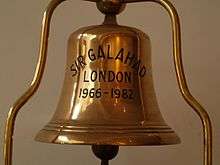RFA Sir Galahad (1966)
Coordinates: 51°50′28″S 58°12′40″W / 51.841°S 58.211°W
 | |
| History | |
|---|---|
| Namesake: | Galahad |
| Builder: | Alexander Stephen and Sons |
| Laid down: | February 1965 |
| Launched: | 19 April 1966 |
| Commissioned: | 17 December 1966 |
| Fate: |
|
| General characteristics | |
| Class and type: | Round Table class LSL |
| Tonnage: | |
| Displacement: |
|
| Length: | 412 ft (126 m) |
| Beam: | 60 ft (18 m) |
| Draught: | 13 ft (4.0 m) |
| Propulsion: |
|
| Speed: | 17 knots (31 km/h) |
| Range: | 9,200 nautical miles (17,040 km) at 15 knots (28 km/h) |
| Capacity: | 2,443 tonnes |
| Complement: | 68 crew, up to 534 passengers |
| Armament: | Two 40 mm Bofors AA guns. |
| Aircraft carried: | Up to 20 Wessex helicopters (1973) |
RFA Sir Galahad (L3005) was a Round Table class landing ship logistics (LSL) vessel belonging to the Royal Fleet Auxiliary of the United Kingdom. She was first managed for the British Army by the British-India Steam Navigation Company, before being transferred in 1970 to the RFA.
Design and construction
The Sir Galahad was a 3,322-tonne LSL built by Stephens and launched in 1966. She could carry 340 troops or, when necessary, 534 for short periods. Cargo capacity could include 16 light tanks, 34 mixed vehicles, 122 tonnes of fuel and 31 tonnes of ammunition. Landing craft could be carried in place of lifeboats, but unloading was mainly handled by three onboard cranes.
Service history
In November and December 1970 Sir Galahad was involved in Operation Burlap giving humanitarian assistance to East Pakistan after a cyclone caused extensive damage and flooding.
Falklands War
Sir Galahad was active during the Falklands War, sailing from HMNB Devonport on 6 April with 350 Royal Marines and entering San Carlos Water on 21 May. On 24 May 1982 in San Carlos Water she was attacked by A-4 Skyhawks of the Argentine Air Force's IV Brigada Aérea and was hit by a 1000 pound bomb dropped by Lt. Luis Alberto "Tucu" Cervera's A-4, (which did not detonate) then strafed by Dagger fighter bombers. After removal of the unexploded bomb, she carried out supply runs to Teal Inlet along with RFA Sir Percivale.
On the 8 June 1982 while preparing to unload soldiers from the Welsh Guards in Port Pleasant, off Fitzroy, together with RFA Sir Tristram, the Sir Galahad was attacked by three A-4 Skyhawks from Argentine Air Force's V Brigada Aérea, each loaded with three 500 lb retarding tail bombs.[1] At approximately 14:00 local time RFA Sir Galahad was hit by two or three bombs and set alight.[2] A total of 48 soldiers and crewman were killed in the explosions and subsequent fire.[3]
Her captain, Philip Roberts waited until the last minute to abandon ship and was the last to leave.[4] He was subsequently awarded the DSO for his leadership and courage.[4] Chiu Yiu-Nam, a seaman on RFA Sir Galahad, was awarded the George Medal for rescuing ten men trapped in a fire in the bowels of the ship.[5]
BBC television cameras recorded images of Royal Navy helicopters hovering in thick smoke to winch survivors from the burning landing ships.[6] These images were seen around the world (dead link).
Other units affected include 3 Troop (of 20 Field Squadron, 36 Engineer Regiment) which was temporarily attached to 9 Independent Parachute Squadron Royal Engineers and was being transported on the Galahad to provide engineering support following the landings. Engineers feature prominently in contemporary footage showing two lifeboats landing survivors. Also 16 Field Ambulance (RAMC) were on board and assisted with the treatment and evacuation of the many casualties.
After the Falklands War

On 21 June, the hulk was towed out to sea and sunk by HMS Onyx; it is now an official war grave, designated as a protected place under the Protection of Military Remains Act.
Guardsman Simon Weston was among the survivors of the attack on Sir Galahad. He suffered 46%[7] burns and his story has been widely reported in television and newspaper coverage. Ten years after Sir Galahad was sunk, Weston was awarded the OBE. Other survivors include the intelligence consultant Crispin Black.[8]
A replacement ship entered service in 1988, carrying the same name and pennant number.
Notes
- ↑ Moro, Rubén Oscar (1985). La guerra inaudita: historia del conflicto del Atlántico Sur. Pleamar, p. 462. ISBN 9505830432. (Spanish)
- ↑ "Task Force Falklands: Goose Green", National Army Museum
- ↑ http://www.thisisannouncements.co.uk/5882332 Obituary for the crew of RFA Sir Galahad
- 1 2 Faith Eckersall (25 September 2010). "Falklands hero's courage under fire". Bournemouth Echo. Retrieved 10 June 2013.
- ↑ "Obituaries:Chiu Yiu Nam". Daily Telegraph. 7 March 2012. Retrieved 10 March 2012.
- ↑ "Falklands War Compilation, (Clip 6)", ITN Source, 1982
- ↑ http://www.simonweston.com/
- ↑ Nick van der Bijl, 5th Infantry Brigade in the Falklands 1982 (2003), p. 135
References
- Raymond Blackman, Ships of the Royal Navy (Macdonald and Jane's, London, 1973)
- SI 2008/0950 Designation under the Protection of Military Remains Act 1986
- Geoff Puddefoot, No Sea Too Rough (Chatham Publishing, London, 2007.)
External links
- Board of Inquiry report into the sinking of the Sir Galahad
- Helicopter goes from Falklands hero to paintball prop